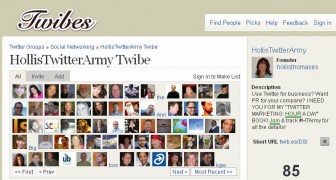The next time you need to get something done, you might want to try appealing to the masses for some help.
Flickr photo courtesy of James Cridland
According to Wikipedia-itself one of the best examples of the technique-”Crowdsourcing is a distributed problem-solving and production model … problems are broadcast to an unknown group of solvers ["the crowd"] in the form of an open call for solutions.”
Online user forums, particularly for IT and tech support issues, have long served as the go-to place for niche answers; today we also have broad-based question-and-answer platforms like Quora, Yahoo Answers and LinkedIn Answers, to name a few. And crowdsourcing has long been used for personal benefit: improving and improvising upon cooking recipes, sharing diet and exercise regimens, and getting beauty and cosmetic video how-to tips on YouTube, for example.
Now crowdsourcing is creeping further into the business world, with virtually endless applications.
Crowdsourcing in Action
To best understand how crowdsourcing works and could be used by your business, let’s take a look at some real-world examples.
New product development: MarketingSherpa reported on an electrical products manufacturer seeking to grow beyond its traditional customer base turned to crowdsourcing and created an online portal where electricians, contractors and inventers could submit ideas for new products. Toy manufacturers have done likewise: Lego has the CUUSOO microsite, and Mattel used crowdsourcing to decide which career the next Barbie doll should have. Even food makers have gotten into the act: Check out these crowdsourcing case studies on Mashable about Ben & Jerry’s, Dunkin’ Donuts, and Vitaminwater.
Building software: Many of us are now familiar with the term “open source,” which basically refers to free software developed collaboratively and shared by developers and programmers worldwide. Linux might be the most well-known crowdsourced software, but communities like SourceForge continue to create other new open source software.
Web design and development: Sites like 99Designs or Crowdspring create an open marketplace where designers can submit designs on a name-your-own-price model; you choose the one you like. The website Threadless has even built its entire business model on crowdsourced T-shirt designs.
Advertising and marketing ideas: Sometimes the best advertising and marketing ideas don’t come from a big agency; they come from your audience. Witness Ford’s first television commercial for its 2013 Focus ST. Inviting attendees to a stunt demo of the new car, Ford asked people to film the event and submit the footage. “About 100 spectators uploaded 580 videos and Ford used bits from 20 different people to create the spot,” the Wall Street Journal reported.
Here’s the resulting spot, by the way: http://youtu.be/sZNS84fqqoc

Research: When I was writing my book, Twitter Marketing: An Hour a Day, I created a “HollisTwitterArmy” on Twibes and asked people to volunteer to help with research for case studies and interview contacts. Using Twitter and the hashtag #HTArmy, I was able to attract and routinely engage recruits; they were invaluable to my book, and let me complete it on deadline. Crowdsourcing can be used for all kinds of other research projects, from the simplest (requests to take a poll or survey) to more complex (identifying patients for health research trials).
Sharing information: Course Hero “offers some 7 million crowdsourced college study materials” and has turned crowdsourcing into a viable business model.
Labor: Need something done? Try Amazon’s marketplace for skilled labor: Mechanical Turk. Need a small or odd task done? Try Fiverr or Tenerr.
Generating content. Lots of different great examples exist, from reporting on news/conducting citizen journalism (NewsIT; spot.us) to authoring whole books (“Enterprise Social Technology“) to generating just about any other content task (Scripted).
Fundraising: Crowdsourcing now enables peers to evaluate and loan money to other peers. For creative ventures, there are sites like Kickstarter, while for businesses, there’s Prosper and Lending Club.
More examples of crowdsourcing can be found on AdRants.
Try It Yourself
Through these examples, by now you’ve probably seen why you might want to crowdsource:
- Execute work you might not be able to do on your own
- Find solutions to problems
- Generate new ideas
- Tap into diverse thinking
- Reduce expenses
- Save time
- Create things
If you decide you want to crowdsource something, first clearly define the outcome you want. This way, you’ll know if the crowdsourced solution measures up.
Then take your mission to the crowd, through any number of online or off-line channels. You could seek assistance from those who already have raised their hand to help (conduct searches, go to resource sites, ask your network for contacts), or you could just put your request out there (to your social network, for example) to see what kind of responses you get.
Only you can judge when the right time to crowdsource might be-but, generally speaking, if you have a specific challenge or task, and think there’s more than one way to get from where you are to where you want to go, chances are good that crowdsourcing can help.
Fair Warning
Like other innovations, crowdsourcing is not a panacea. Don’t go in blindly or with unrealistic hopes and expectations. Do question results: Judge for youself whether the solutions you get are the best ones for your business; and ask yourself if you’re compromising because the crowdsourced solution seems cheaper.
But also don’t be afraid to try crowdsourcing. You might be quite pleased with and inspired by the results. And if you do, you should share what you find with the rest of us!
I actually crowdourced some ideas for this article. Special thanks to James Lee, Steve Hall, Marivic Valencia, Jaime Hood, Sean X, Dan Gray, Matt Prohaska, Melinda Wittstock, Tom Cunniff, Larry Smith, Kevin Lee, Susan Greenspan Cohen and Matt Palumbo.
Comments(0)»
Leave a comment
Web Ad.vantage is a full-service online marketing company with core competencies in search engine optimization, PPC Campaign Management and online media buying. Visit our Internet Marketing Services section to learn more about our full range of services.
WebAdvantage.net encourages the reprinting of our marketing tips and articles. Before doing so, however, please contact us at for permission to do so. The company bio located above is required to accompany any reprint. Thank you in advance for your professional courtesy.
Pragmatic, professional advice with no hidden agenda.

Internet Business Forum







 back to top
back to top






